Whether it’s because your cupboards are overflowing, you’re moving house, or you just watched Marie Kondo on Netflix and want to put that motivation to good use, there are times when we look at our fabric stashes and ponder going through it all to get rid of the pieces we don’t use, love, and/or want anymore. But it can be overwhelming, knowing where to start, and how and where to destash.
I’m most certainly no KonMari expert, but I have just moved houses a couple of months ago, and into my own sewing room, which required a big week of organisation. Having come from our bedroom and part of our wardrobe, I needed to buy a cupboard for my stash. But when it arrived, and I began to empty the plastic tubs of fabric, I felt overwhelmed. I didn’t want to keep all this fabric and have it filling my brand new cupboard, knowing that I had moved on from the prints.
The majority of the fabrics in this category were from quilt projects I had completed (or almost completed!) and my joy and desire to create with the prints had been satiated; it was time to let go and let someone else love them and use them. Then there were the old WIPs and orphan blocks, many of which I hadn’t even seen in 3 years as they were lost in storage in the move back from Japan. Reuniting didn’t reignite many strong feelings of nostalgia, just a sense of meh as I unpacked them all. So what to do, what to do?
Note – be prepared to make a mess. Be prepared to have a mess for a few days!
Step 1. If you’re not sure where to start, start with the things you know you definitely don’t want.
I decided to start with what I knew I didn’t want to keep anymore. I started pulling out the fabrics and projects that I knew I didn’t want to have to find a new home for!
Pull out the orphan blocks you know you’ll never get back to, that pile of blocks waiting to be put into a quilt top, the leftover fabrics from a finished quilt still sitting together in the corner. It may seem corny to some of you, but if something doesn’t “spark joy” anymore, pull it out. In such a creative endeavor as quilting, that idea of sparking joy really does apply – if you don’t want to create with it, it’s just dust collectin’ space filler! Let go and let someone else love it and use it.
Once you’ve started with the things you know you don’t want to keep, it helps to put everything else into perspective as it gives you a scale to rank things on from that much-beloved fat quarter bundle still in its ribbon beautifully displayed on a shelf to the pile of bee blocks from 5 years ago in the donate pile. Where on that scale does everything else fall? Try to be on the stricter side of things with yourself. I’m not saying to cull everything, but if you know you haven’t touched that yellow fat quarter in four years, do you really need it?
Step 2. Think about your quilting needs
As you’re going through the rest of your stash, have a think about how and what you sew. Think about the types of things that you make a lot of and the projects you have sewn over the past couple of years. What does your quilting track record reveal about what fabrics you actually do love and use?
Do you make a lot of bee blocks? Then you’re probably needing to keep a good range of fat quarter blenders throughout the rainbow so that you have the right colours to meet the queens’ requests, in a mix of lights and darks.
Do you make quilts for all the children in your life? Then you will be more likely wanting to keep the novelty feature prints.
Are you a scrappy quilter? Then your overflowing scrap bucket will come in handy and it’s time to sort out a good organisational system for them.
Do you adore quilting by fabric range or designer? Then holding onto that bundle of rare out of print designer fabric makes total sense.
Are you a Strictly Solids type of quilter? Then holding onto cuts of solids whether big or small is probably more useful for you.
Take this time to reflect on what things you keep reaching for. There is nothing wrong with holding on to that rare out of print designer fat quarter bundle even if you never make quilts from just one designer, but this is the opportunity when you can really get focused on making your stash work for you. And don’t let “Just In Case” become the anthem of your destash! If you haven’t touched it in years, you’re not likely about to suddenly start using that print in every project.
Step 3. Sort out the destash piles
Once you’ve pulled out everything you want to destash, it’s then time to sort it out into the sell pile and the donate pile. Orphan blocks, random fat quarters, the novelty prints, and leftover strips and squares are great to donate to your local quilt guild for charity sewing, or directly to your local quilting charity. For example, many children’s hospitals have a organisation that make quilts for patients. Have a Google and see what you can find, and what their requirements are for donations. Here in Melbourne, I choose to donate to Very Snuggly Quilts.
As for the selling pile? Here’s where it gets a bit more tricky – not everything you have to destash will all sell in the one place. By that, I mean that there are various options for selling destash fabrics, and you need to choose carefully so as to make the most of your time and get things sold more efficiently. Think about what kinds of quilters are going to be buying your destash, and where they hang out. If you’re a more modern quilter, Instagram is great for destashing modern fabrics. Whereas for the more traditional and/or odds and ends fabrics, I’ve found better luck for those prints in Facebook groups. Some of the really hot-seller designers like Tula Pink have specific Facebook groups where you can quickly sell popular older prints. Ebay is another option if it’s something rare and out of print and popular.
I have a long post all about how to host an Instagram destash that I will be sharing in the next few days, so stay tuned for that if you’re wanting to get some ideas on that for your destash!
Step 4. Put away everything else in a logical manner.
Once you have the piles to donate and destash separated out, it’s time to put everything else away. However you choose to organise your fabrics and projects, make sure that everything has a place – somewhere specific to put it away when you’re finished using it.
Fold the larger pieces of fabric neatly so that you can easily see what you have, and store like with like – blenders folded in the same way in colour order for easy access, background and backing yardage kept together, those special Liberty fabrics and designer fat quarter bundles in their own places.
If you’re a scrap quilter, store the scraps in a way that makes them easily accessible for how you quilt – by colour or size. Make sure that you have a scrap bin in easy reach of your cutting mat to put bits in as you go (and then empty it properly once it’s full!).
Gather all those little scissor snips and quilting clips and notions you’ve found along the way and put them away properly… I think the sewing desk drawers need a post of their own!
Step 5. Enjoy the order you have now restored to your space, and get creating.
There is nothing like a clean slate to inspire creativity! With clear work spaces, and the emotional baggage of old projects cleared out from your life, there is no more hindrance to creating – whether it be something new, or continuing to work on a WIP that you’ve rediscovered your love for through this process!
What are your tips for clearing out your sewing room? Share them with us in the comments below!
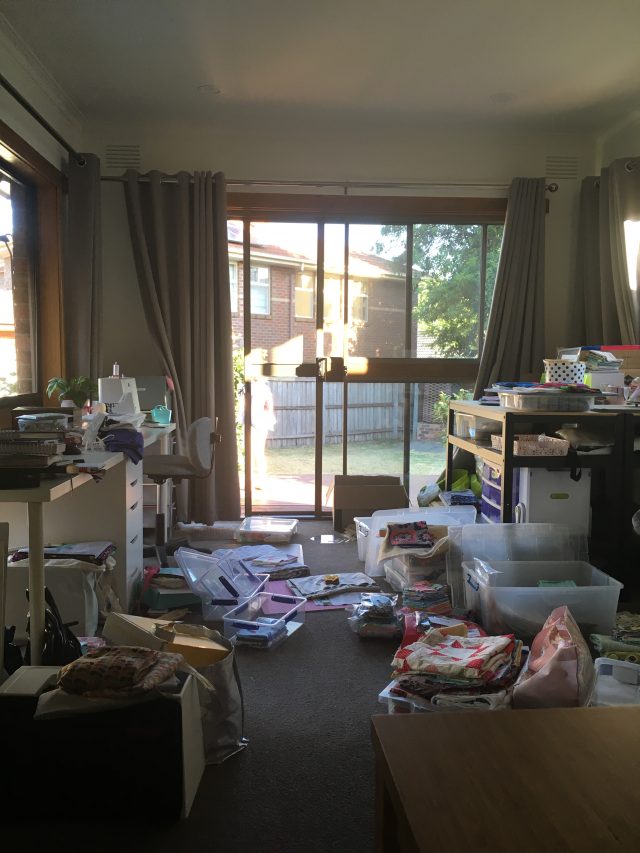
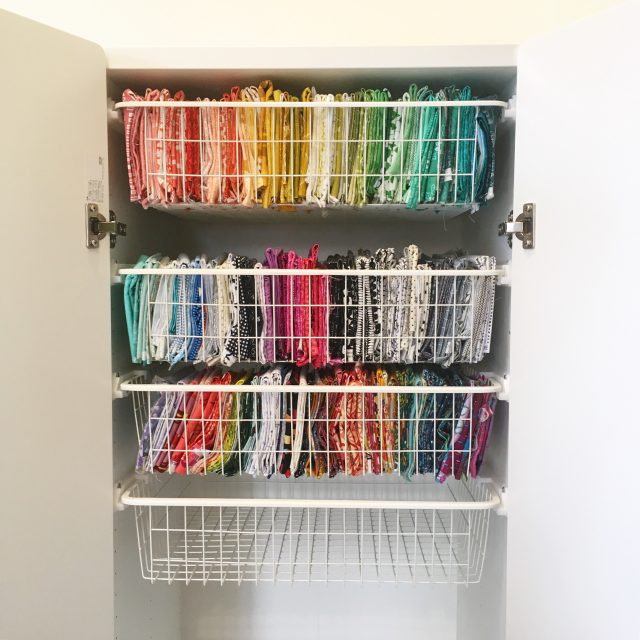
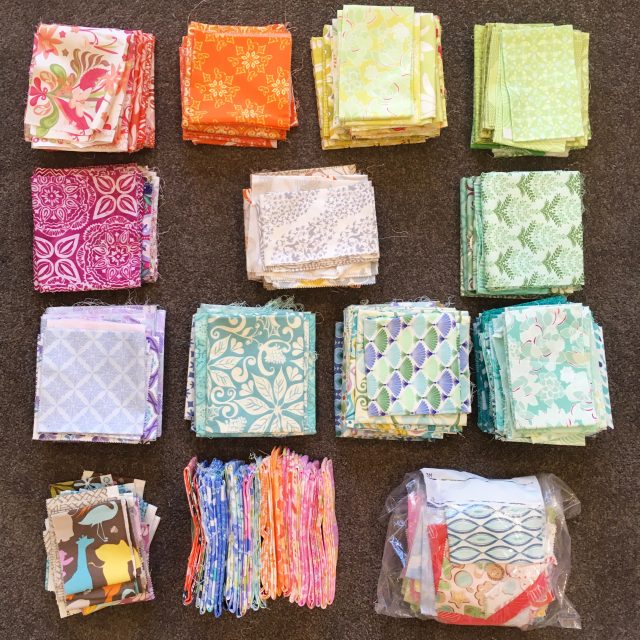
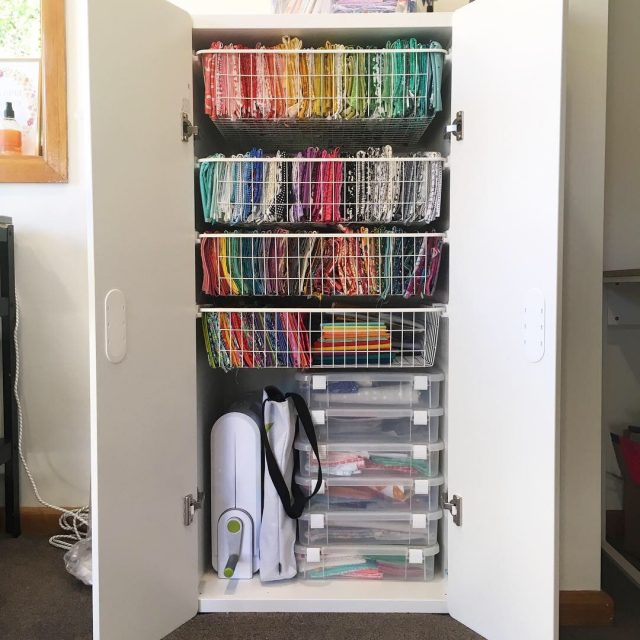
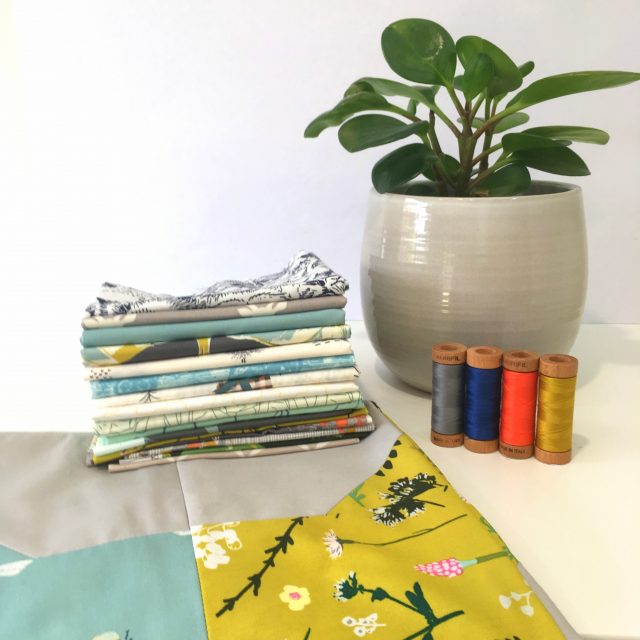
Carole @ From My Carolina Home says
I recently did this too, and ended up just getting rid of two huge bags of scraps as they were just weighing me down. I did a similar post to yours some time ago doing the same basic thing with your wardrobe – and I need to do that one again as my closet is still too full. I agree, making a mess is part of the process!
Alyce says
Isn’t it so freeing to be rid of it all?!
Kay says
I go through my fabric a couple of times a year and pass things on to a friend usually. I actually enjoy getting rid of things and having more space. I am also trying not to buy more fabric for a while as I honestly have so much to use, unless it is something like larger pieces for a quilt back. I gave away a large pile to a young niece just before Christmas who is starting to sew, she was thrilled and didn’t care what it looked like as she had plenty to play with now. x
Alyce says
Yes, I love that cleansed feeling after doing this!
Clare Baker says
That is one fabulous cupboard! Where oh where is that from?!!!!
Alyce says
It’s the Stuva from Ikea, with 4 wire baskets instead of any other wardrobe option. I love it!
Rosemary B says
Good ideas. I often wonder what a burden it is for those who just keep every single thing. There are plenty out there, and yes, maybe they suddenly happen upon some old fabric or project that bursts into a massive artistic endeavor. Either way, I give away a lot of fabric to my friend Precious Lopez. She has a sewing school. Sometimes I get that feeling like I should save everything, but just like with our clothing.
some things are special, and some things you should let go, and know that they will be used and useful to someone. That makes my heart happy
Alyce says
I agree! Too much makes me feel so stressed and cluttered.
Kitty says
While de-stashing last year I noticed an abundance of green fabrics so I challenged myself to create a green quilt. Top and backing are green. I experimented with a ruler on the back and did a version of disappearing nine patch on the front. I had a piece of very old Charles Wysocki fabric as my focal fabric. I recommend you try something like this. Good thinking exercise and I used a lot of fabric.
Alyce says
Oh yep, there are some things I’ve kept to specifically use as a fabric pull for quilts!
Patty says
Love this post. In January I pulled out all my fabric, sorted by color/patterns and neatly folded them into containers in a system that works for me. I also sorted my sewing area drawers and supplies. It’s so nice to be able to find everything easily. I have a huge bagful of destashed fabrics to take to my monthly guild meeting for our free table, which is available to members for their perusal and use. Thank you for the inspiration.
Alyce says
How nice is it to start the year afresh?!
Martha Crutchfield says
I am teaching my self to quilt using left over pieces of fabric that was given to me or from clothes that I have been cutting up. Now I have been practicing paper piecing which has been a challenge! My quilts have been small since I use them to put on our cat trees. At this time, I do not have a fabric stash.
Alyce says
That’s a fantastic way to learn! Recycling old clothes is how quilts first began 🙂
Marie Spodek says
I’ve been taking fabric pieces to FABSCRAP in Brooklyn, NY…they are expanding and selling on the Internet as well. They get fabric scraps from fabric companies in NYC and designers, etc. Fabrics are sorted and if large enough, are put in a room for sewists to sort through. Small ugly pieces are ultimately recycled, generally shredded into insulation.
Yesterday, I took a vary LARGE suitcase and nearly-as-large box of fabrics. I said, don’t let me see anything from inside…
Alyce says
What a fantastic initiative!!